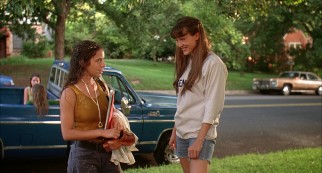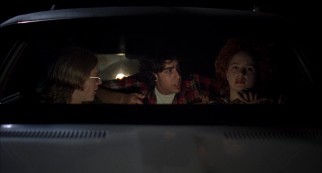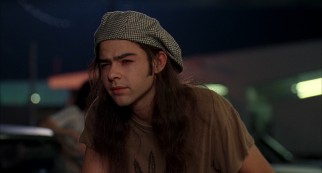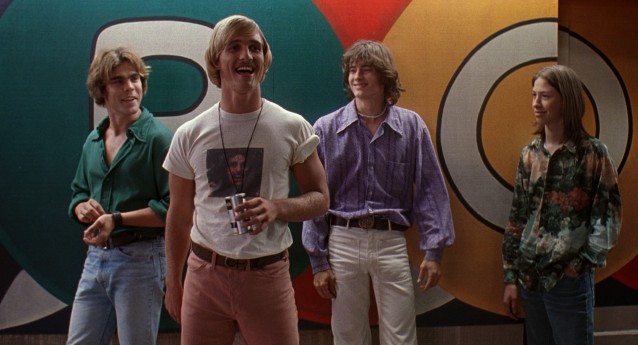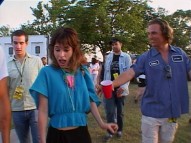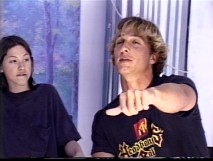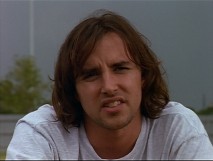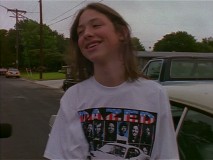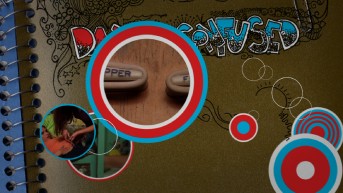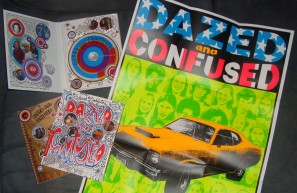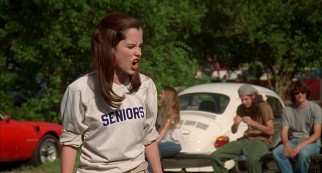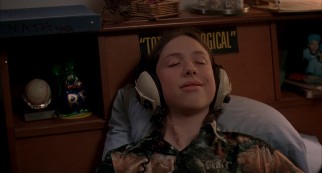Dazed and Confused: The Criterion Collection Blu-ray Review
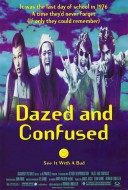 |
Dazed and Confused
Theatrical Release: September 24, 1993 / Running Time: 102 Minutes / Rating: R / Songs List Writer/Director: Richard Linklater Cast: Jason London (Randall "Pink" Floyd), Joey Lauren Adams (Simone Kerr), Milla Jovovich (Michelle Burroughs), Shawn Andrews (Kevin Pickford), Rory Cochrane (Ron Slater), Adam Goldberg (Mike Newhouse), Anthony Rapp (Tony Olson), Sasha Jenson (Don Dawson), Marissa Ribisi (Cynthia Dunn), Deena Martin (Shavonne Wright), Michelle Burke (Jodi Kramer), Cole Hauser (Benny O'Donnell), Christine Harnos (Kaye Faulkner), Wiley Wiggins (Mitch Kramer), Mark Vandermeulen (Tommy Houston), Esteban Powell (Carl Burnett), Jeremy Fox (John Hirshfelder), Ben Affleck (Fred O'Bannion), Jason O. Smith (Melvin Spivey), Christin Hinojosa (Sabrina Davis), Parker Posey (Darla Marks), Matthew McConaughey (David Wooderson), Catherine Morris (Julie Simms), Nicky Katt (Clint Bruno), Terry G. Mross (Coach Conrad), Kim Arnette Krizan (Ms. Ginny Stroud), Julius Tennon (Mr. Payne), Richard Dillard (Frank Pickford), John Swasey (Beer Delivery Guy), Mona Lee Fultz (Mitch's Mother) |
Buy Dazed and Confused: Criterion Collection from Amazon.com: Blu-ray DVD
The parallels between American Graffiti and Dazed and Confused are numerous. Each film dramatizes a single eventful day and more so night of an ensemble of young people on the verge of adulthood. Both were set in a past just distant enough to wax nostalgic about. Each is drawn from the real experiences of its young writer/director, for whom they each numbered as the second traditional narrative feature film credit. One area where Graffiti and Dazed differ is in their receptions. The former was one of the biggest hits of all time at the box office and won critical approval to go with it, picking up Oscar nominations in five major categories. Dazed was given a limited theatrical release and its only nominations came from Switzerland and the Young Artist Awards. Nonetheless, Dazed soon grew into a cult classic, aided in part by countless cable airings and subsequent fame achieved by a number of its cast members. When The Criterion Collection admitted the movie into its prestigious ranks back in 2006 with a 2-disc DVD, the selection wasn't questionable by critical reputation. Still, it stood out on account that the movie had long since grown into a widely known and popular entity, the kind less frequently celebrated by Criterion than comparably obscure foreign and independent fare.
Linklater's follow-up to his seminal 1991 professional debut Slacker (which went Criterion in 2004), Dazed and Confused is set on May 28, 1976, the last day of the school year in small-town Texas. That is cause for excitement in upperclassmen and trepidation in future freshmen, who are promised degrading physical and verbal abuse as per hazing traditions. The film casts a wide net, familiarizing us with no fewer than twenty individuals, most falling into one of those two classes. We seamlessly float from one group to another, with each spilling into the next.
Among the most focal of characters and closest to protagonists are star quarterback Randall Floyd (Jason London) and freshman-to-be Mitch Kramer (Wiley Wiggins). Randall is in the midst of moral dilemma, because the football team's coach has requested all players sign a pledge denouncing the use of drugs and alcohol. Mitch, meanwhile, is one of a group of baseball-playing 8th grade grads on the run from thrill-seeking tormentors; his big sister's (Michelle Burke) warning only earns him special notice from the sadistic, butt-paddling Fred O' Bannion (Ben Affleck) and cronies.
Another thread of interest involves a trio of nerdy seniors (Anthony Rapp, Adam Goldberg, and Marissa Ribisi), who for once try to sow their wild oats like their classmates regularly do.
Mostly, beer, marijuana, and good times flow. Even though the much-anticipated unsupervised house party gets busted (due to an early keg delivery), the fun simply relocates, from a pool hall to a drive-in burger joint to the moon tower-lit woods to the 50-yard line of the school football field.
The film aims very clearly to be the same kind of generational coming-of-age classic that American Graffiti was hailed as. But Lucas' movie was the early '70s version of the early '60s, where drag racing and underage liquor store purchases were the height of shenanigans. The early '90s version of the mid-'70s is decidedly R-rated, full of profanity and drug use. I suspect the content limited the movie's shots at wide release and accolades. It will also probably turn off some viewers today. In truth, there is no denying that the movie glorifies pot and underage drinking. Both are prevalent and without negative consequence. That's believable enough for a typical day and we leave the film before hangovers can set in. Certainly, that sets a bad example for teenagers, particularly the easily influenced kind whose own misadventures could be much more harmful.
But, though understandably embraced by them, Dazed and Confused isn't so much aimed at present teenagers as past ones. The film serves a slice of adolescence, as Linklater recalls it in Bicentennial Texas. It isn't sugar-coated or cleaned up. The director/lone writer doesn't even try to ascribe meaning to the 18 or so hours depicted. (Lucas' closing "where are they now" screens are about the only thing in Graffiti I don't like.) He just tries to present the episodes authentically and, by all accounts, he succeeds while keeping us consistently entertained. This movie is full of flavor and energy which will appeal to you even if your own high school experiences were or are far removed from these (and my own couldn't be much further).
The undeniable senses of nostalgia and awareness remove any suspicion that you are watching mindless, ribald hijinks (though, in a way, you are). There isn't a moment in the film that doesn't shout "1970s", from the fashions and vehicles down to the lingo. The era is reinforced most of all by the soundtrack, which seems like the definitive compilation for the decade. Twenty-nine now "classic" rock songs play, almost all of them immediately recognizable. Though there are plenty of major acts not represented here -- for instance, Elton John, David Bowie, John Denver, and Led Zeppelin (from whom the title is drawn) -- those that are share a similar mindset and youthful appeal. So distinctive and well-picked is the music that anything missing the cut seems to have been knocked down in stature and anything used -- like Aerosmith's "Sweet Emotion", Alice Cooper's "School's Out" and "No More Mr. Nice Guy", War's "Low Rider" and "Why Can't We Be Friends?", Nazareth's "Love Hurts", Bob Dylan's "Hurricane", Edgar Winter Group's "Free Ride", Lynyrd Skynyrd's "Tuesday's Gone", and Foghat's "Slow Ride" -- solidified as cultural hallmarks, whether or not they previously held that honor.
Perhaps it was inevitable that a film with such a large young cast would produce some major movie stars. Affleck was a few years away from his big break (Good Will Hunting) and subsequent leading man status. Having since weathered his laughingstock status of the early 2000s, he has returned to respectability on both sides of the camera in recent years. Matthew McConaughey enjoys his first film credit of note (second of all, after "Guy #2" in the subsequently-shot My Boyfriend's Back) as working man David Wooderson, who is still hanging onto his high school mentality. For every one of those four big names, there are a couple of promising others who have not gone on to bigger things. London has kept busy but in nothing to boast about; for a while at least, his twin brother Jeremy fared better on TV and film. Wiggins reteamed with Linklater as the lead of the trippy, existential 2001 rotoscoped animated feature Waking Life, but has otherwise left the industry. Whether still acting or not, Wiggins' fellow young cast members have also remained scarce. I see some many IMDb credits (and on familiar titles) for other prominent performers, Rory Cochrane (who plays an iconic easygoing stoner) and Sasha Jenson (a loudmouth), but I'd be lying if I claimed I ever recognized them in anything else. Likewise, though Cole Hauser joined Affleck (his fellow troublemaker here) on Good Will Hunting and has some other high-profile film credits to his name, I haven't seen him or given him a thought in over ten years.
Joey Lauren Adams and one-time indie queen Parker Posey have both had their fair share of noteworthy film credits (the former in Kevin Smith movies and Big Daddy, the latter in an array of films including Superman Returns), although lead roles have eluded both actresses for some time. Rapp, who I'll always identify with his humorous Adventures in Babysitting turn, has had success on Broadway (originating the lead role of Rent and reprising it for the 2005 film); he and Goldberg reteamed as Russell Crowe's grad school friends in 2001 Best Picture Oscar winner A Beautiful Mind.
Not only has Dazed and Confused rose to cult classic status, but it seems to rank among the best-selling catalog titles for Universal Studios, who inherited it from their Gramercy Pictures division (a folded precursor to Focus Features) and now promotes it with the likes of Fast Times at Ridgemont High. Universal treated Dazed to a Flashback Edition back in 2004 and just this past August debuted it on Blu-ray (both times, day and date with Fast Times). Seemingly at odds with that, Criterion tossed its cap into the ring late last month with its own pricier, much more substantial Dazed Blu-ray, spine number 336, which we review here.
VIDEO and AUDIO Unsurprisingly, Dazed and Confused looks outstanding on Criterion's Blu-ray. Supervised by Linklater, the transfer is sure to please all with its spotless picture and strong colors. A tiny bit of grain creeps into some scenes, though fewer than you'd suspect given the low budget and frequently dark settings. I would rank this among the best live-action '90s movie BD transfers I've seen. The default 5.1 DTS-HD master audio is slightly underwhelming by comparison. Dialogue is sufficiently crisp and the music lively, but the mix is really anchored in the front channels. As it was probably plain stereo in theatrical release, that is faithful to the film's original design at least.
BONUS FEATURES, MENUS, PACKAGING and DESIGN Criterion hangs onto its full, satisfying slate of Dazed and Confused extras, presenting all video supplements in HD resolution. Things start with a solo audio commentary by writer/director Richard Linklater, recorded January 2006. The autobiographical, modestly-budgeted, and inexperienced natures of the movie ensure he is engaging. He talks without lull on many interesting topics, including the thought behind music selections (and ones prevented by the budget's limitations); Seventeen deleted scenes (25:32) can be viewed individually or as a group. Some fill in insignificant gaps, others extend existing bits. There's also more time spent with the bullies, the girls, and the nerds, all of whom engage in political and philosophical conversation on everything from death to Japanese immigrants to "Welcome Back, Kotter." The scenes are scratchy and, lacking score and song, unusually quiet. Still, they go above and beyond most deleted scene sections, especially for pre-DVD films. "Making Dazed" (45:35) is a great documentary that first aired on AMC in 2005. It offers then-new interviews with Linklater, producers James Jacks and Sean Daniel, casting director Don Phillips, and actors Jason London, Ben Affleck, Matthew McConaughey, Wiley Wiggins, Anthony Rapp, Adam Goldberg, Marissa Ribisi-Hansen, Parker Posey, and Christin Hinojosa. It also shows us pieces of audition tapes, a wealth of behind-the-scenes footage and interviews from the 1992 shoot, and clips from the 10th anniversary Austin reunion screening. Among the topics recalled are casting unknowns, the tight production schedule, Linklater's input-welcoming creative process, the growth of McConaughey's part, profanity concerns, Linklater's limited authority, test screenings, the studio's distribution failings, what followed for the actors, and the movie's rise to cult classic status. This is one of the best making-of docs I've ever seen.
Auditions (23:19) are provided for the following twelve actors: Michelle Burke, Rory Cochrane, Adam Goldberg, Cole Hauser, Christin Hinojosa, Nicky Katt, Jason London, Deena Martin, Matthew McConaughey, Anthony Rapp, Marissa Ribisi, and Wiley Wiggins. They perform early versions of scenes or entirely scrapped ones, sometimes across from Linklater himself. There's not much to say about these, but they're as interesting as any audition tape, with the most interesting part being the glimpses of the young actors themselves out of character. Beer Bust at the Moon Tower holds a treasure trove of content from production. Filmed on the first week of rehearsals, Character Interviews (40:32) let thirteen lead actors (Hinojosa, Sasha Jenson, Ribisi, London, Burke, Wiggins, Posey, Goldberg, Affleck, Hauser, Rapp, Cochrane, and Martin) answer questions either in first-person or third-person about their character's lives and families. Unusual and fascinating, these direct camera addresses show us how much thought went into these roles beyond what makes it onto the screen. Twelve Cast and Director Interviews (47:40) gather thoughts from Linklater on the eve of filming and from the following actors during production: Posey, Affleck (who is eventually joined by Hauser), Katt and Goldberg (twenty minutes after shooting their supposedly Nyquil-fueled fight scene), a quickly-confused Cochrane, Wiggins and Catherine Morris (before, during, and right after their kissing scene), Wiggins by himself, Burke and Christine Harnos, and Hinojosa. The cast members are charismatic and candid; among the most memorable moments are Affleck lamenting the lax morals of the '70s and Hinojosa getting emotional on her final day of filming. Linklater appears again on the last day of shooting, full of reflections. Finally, in 2004, he teams with casting director Phillips and McConaughey to recall how the actor landed what was his first film role.
Behind-the-Scenes Footage (30:39) is comprised of thirteen listings. They include rehearsals, Ben Affleck's clutch driving lesson, costume designer Isabelle Coulet silently and expressively modeling outfits, set group interviews, B-roll from takes and photo shoots, the girls lounging in their hotel room, a tour of the prop room (holding fake drugs, real bongs, and individualized paddles), tagging along with Wiggins on his first day of summer following the shoot, and some brief looks at the 10th anniversary reunion screening in Austin. This outstanding grants us the kind of access you dream of having on your favorite film. The Beer Bust section can also be enjoyed with a "Random Play All" that bounces you around from one section to another, eventually treating you to all two hours of material. Finally, there is the movie's original theatrical trailer (1:58), which emphasizes the party aspects (tagline: "See it with a bud.") and establishes 1976 as "before MTV, before safe sex, and way before Beavis & Butthead." Some extras from Universal's Flashback Edition DVD and Blu-ray appear not to be included here: fake anti-marijuana educational short "The Blunt Truth" and real '70s PSAs "VD is for Everybody" and "Crying Indian." In fact, the best of those, the famous 1-minute "Crying Indian" spot, is hidden among the disc's files (00374.m2ts), though I don't know that you can access it without a BD-ROM drive and time on your hands. The other losses do not come close to comparing with the gains of Criterion's bounty of excellent bonus features. Universal's releases include nine deleted scenes running 14½ minutes (about two-thirds of this disc's equivalent), but everything else is exclusive to Criterion's editions.
The menu emulates the cover artwork with sounds Criterion's Dazed and Confused Blu-ray retains the cover art design of its 2006 DVD, which resembles a school yearbook with its candid pictures and spontaneous doodlings. Those pictures actually are part of a Digipak below, which departs from the studio's standard clear keepcase. The Digipak freely holds what folds out to be a very cool neon-colored 14" x 20" poster featuring yearbook-type individual shots of the cast and prominently featuring the orange 1969 Pontiac GTO Judge from the movie. The poster is adapted from Frank Kozik's world premiere one-sheet. Here, the usual Criterion booklet is a full-blown, 72-page softcover book, whose covers resemble a spiral notebook and insides are designed more like a yearbook. This fine, winningly illustrated publication starts with a chapter and cast list (the former graciously identifying the songs in each scene). It goes on to supply four substantial essays on the film. Kent Jones' 5-page "Dream On" gives us a succinct analysis. Jim DeRogatis' "The '70s Obviously Sucked - NOT! (Or At Least Not the Music, Anyway)" naturally celebrates the movie's musical selections as a reflection of the era. Chuck Klosterman's "Not So Long Ago, But Very Far Away" recalls his much-anticipated, disappointing first viewing of the film and how he has since come to admire it again and again (high). By far longer and more revealing than the rest is "The Spirit of '76", an article published in an October 2003 issue of Texas Monthly to celebrate the film's tenth anniversary. In it, John Spong gathers recollections from Linklater, casting director Don Phillips, co-producer Anne Walker-McBay, cinematographer Lee Daniel, and several cast members. The book proceeds with Linklater's notes to the cast and crew, followed by biographies and facts for 20 characters from the film. These profiles, created for the movie's original 1993 companion book, are really detailed and enlightening. The transfer information and acknowledgements sections are spruced up with some quotes from the movie.
CLOSING THOUGHTS Richard Linklater's Dazed and Confused takes period recreation to admirable heights with its American Graffiti-type day in the life tale of 1976 Texas teenagers. Favoring characters, atmosphere, and classic rock over a conventional narrative, the movie entertains thoroughly and resonates strongly with its flavorful presentation. Criterion's Blu-ray is everything a fan could want, providing a first-rate feature presentation, a sturdy companion book, a cool poster, and nearly six hours of supplements, most of which rank up there with the very best bonus features around. Though the movie isn't an all-time favorite, I do find it highly enjoyable and this fantastic, loaded release elevates it to a strong recommendation for anyone fond of or even just interested in seeing the film. Support this site when you buy Dazed and Confused from Amazon.com: |
Related Reviews:
Dazed and Confused: The Film Soundtrack Everyone Will Be Talking About: Download Amazon MP3s Buy CD from Amazon.com Download from iTunes
Even More Dazed and Confused: They Found Your Stash...Again!: Buy CD from Amazon.com DVDizzy.com | DVD and Blu-ray Reviews | New and Upcoming DVD & Blu-ray Schedule | Upcoming Cover Art | Search This Site
DVDizzy.com Top Stories:
New: Island of Lost Souls (Criterion Collection) The Tree of Life Planes, Trains & Automobiles Terri Bad Teacher
Ben Affleck & Matthew McConaughey: Glory Daze | Milla Jovovich: Stone | Matthew McConaughey: Tropic Thunder
1970s: That '70s Show: Season One The Runaways Our Very Own Remember the Titans Semi-Pro
High School: Ferris Bueller's Day Off Varsity Blues Say Anything... Superbad 10 Things I Hate About You Footloose
1990s: Beavis and Butt-Head: Mike Judge's Most Wanted Fear and Loathing in Las Vegas Bottle Rocket
Youth Nostaglia: Adventureland
Dazed and Confused Songs List (by order of first use): Aerosmith - "Sweet Emotion", Deep Purple - "Highway Star", Alice Cooper - "School's Out", Black Oak Arkansas - "Jim Dandy", War - "Why Can't We Be Friends?", Ted Nugent - "Stranglehold", Edgar Winter - "Free Ride", Alice Cooper - "No More Mr. Nice Guy", Peter Frampton - "Do You Feel Like We Do", War - "Low Rider", Bob Dylan - "Hurricane", Foghat - "I Just Want to Make Love to You", Nazareth - "Love Hurts", Black Sabbath - "Paranoid", Head East - "There's Never Been Any Reason", Sweet - "Fox on the Run", ZZ Top - "Tush", Rick Derringer - "Rock & Roll Hoochie Koo", Foghat - "Slow Ride", Black Oak Arkansas - "Lord Have Mercy on My Soul", Peter Frampton - "Show Me the Way", ZZ Top - "Balinese", KISS - "Rock & Roll All Nite", The Steve Miller Band - "Livin' in the U.S.A.", Dr. John - "Right Place, Wrong Time", Ted Nugent - "Hey Baby", The Runaways - "Cherry Bomb", Lynyrd Skynyrd - "Tuesday's Gone", Seals & Croft - "Summer Breeze"
Text copyright 2011 DVDizzy.com. Images copyright 1993 Gramercy Pictures, Alphaville Productions, and 2011 The Criterion Collection and Universal Studios.
Unauthorized reproduction prohibited.
